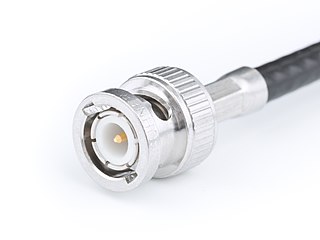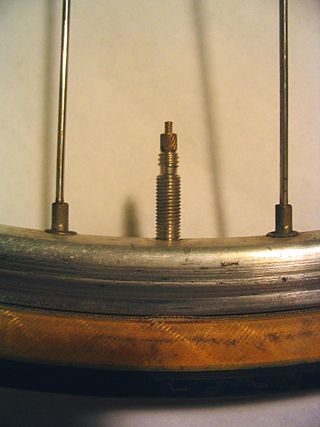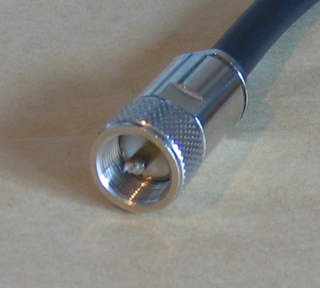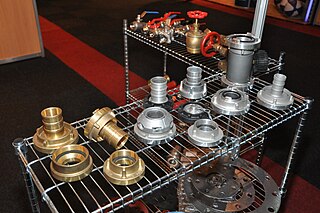
Coaxial cable, or coax, is a type of electrical cable consisting of an inner conductor surrounded by a concentric conducting shield, with the two separated by a dielectric ; many coaxial cables also have a protective outer sheath or jacket. The term coaxial refers to the inner conductor and the outer shield sharing a geometric axis.

The BNC connector is a miniature quick connect/disconnect radio frequency connector used for coaxial cable. It is designed to maintain the same characteristic impedance of the cable, with 50 ohm and 75 ohm types being made. It is usually applied for video and radio frequency connections up to about 2 GHz and up to 500 volts. The connector has a twist to lock design with two lugs in the female portion of the connector engaging a slot in the shell of the male portion. The type was introduced on military radio equipment in the 1940s and has since become widely applied in radio systems, and is a common type of video connector. Similar radio-frequency connectors differ in dimensions and attachment features, and may allow for higher voltages, higher frequencies, or three-wire connections.

A coaxial RF connector is an electrical connector designed to work at radio frequencies in the multi-megahertz range. RF connectors are typically used with coaxial cables and are designed to maintain the shielding that the coaxial design offers. Better models also minimize the change in transmission line impedance at the connection in order to reduce signal reflection and power loss. As the frequency increases, transmission line effects become more important, with small impedance variations from connectors causing the signal to reflect rather than pass through. An RF connector must not allow external signals into the circuit through electromagnetic interference and capacitive pickup.

The APC-7 connector is a precision coaxial connector used on laboratory microwave test equipment for frequencies up to 18 GHz. APC-7 connectors are advantageous because they have a low-reflection coefficient, make repeatable coaxial connections, and are genderless. The connectors are expensive, so they are seldom used outside the laboratory where their cost can be justified by their accuracy and convenience. Due to their high cost, their 18 GHz frequency limitation, and new laboratory practices, the connectors are now uncommon. Modern low frequency microwave equipment often uses the less expensive 3.5 mm (26.5 GHz) connector. Higher frequency equipment must use higher performance connectors such as the 2.92 mm (40 GHz), 2.4 mm (50 GHz), 1.85 mm (67 GHz), or 1.0 mm (110 GHz) connectors.

The N connector is a threaded, weatherproof, medium-size RF connector used to join coaxial cables. It was one of the first connectors capable of carrying microwave-frequency signals, and was invented in the 1940s by Paul Neill of Bell Labs, after whom the connector is named.

The F connector is a coaxial RF connector commonly used for "over the air" terrestrial television, cable television and universally for satellite television and cable modems, usually with RG-6/U cable or with RG-59/U cable.

SMA connectors are semi-precision coaxial RF connectors developed in the 1960s as a minimal connector interface for coaxial cable with a screw-type coupling mechanism. The connector has a 50 Ω impedance. SMA was originally designed for use from DC (0 Hz) to 12 GHz, however this has been extended over time and variants are available to 18 GHz and 26.5 GHz. There are also mechanically compatible connectors such as the K-connector which operate up to 40 GHz. The SMA connector is most commonly used in microwave systems, hand-held radio and mobile telephone antennas and, more recently, with WiFi antenna systems and USB software-defined radio dongles. It is also commonly used in radio astronomy, particularly at higher frequencies (5 GHz+).

SMC connectors are coaxial RF connectors developed in the 1960s. The interface specifications for the SMC and many other connectors are referenced in MIL-STD-348. They use a #10-32 UNF threaded interface. They offer electrical performance from DC to 4 GHz. Some extended performance versions are rated to 10 GHz The normally free part of a SMC connector have a socket for the center contact so are Female.The normally fixed part SMC connectors have a pin for the center contact so are Male. This is the reverse of most RF connectors. SMC jack connectors have an external thread while SMC plug connectors have the mating hex nut. The contact dimensons are identical to the snap-fit SMB. Available in 50-Ohm and 75-Ohm characteristic impedance, they provide an interconnect means for small form factor coaxial cables and printed circuit boards where small footprint is important.

FME is a miniature 50Ω RF connector series offering excellent performance from DC to 200 MHz used primarily with RG-58 or equivalent coaxial cables employed in mobile applications and installations.

In electrical and mechanical trades and manufacturing, each half of a pair of mating connectors or fasteners is conventionally assigned the designation male or female. The female connector is generally a receptacle that receives and holds the male connector. Sometimes the terms plug and socket or jack are used, particularly in reference to electrical connectors. In some cases, the pins on the connector may have the opposite nominal gender to the mounted connector, such as the RCA connector.

The Presta valve is a tire valve commonly found in high pressure road style and some mountain bicycle inner tubes. It comprises an outer valve stem and an inner valve body. A lock nut to secure the stem at the wheel rim and a valve cap may also be present.

An optical fiber connector joins optical fibers, and enables quicker connection and disconnection than splicing. The connectors mechanically couple and align the cores of fibers so light can pass. Better connectors lose very little light due to reflection or misalignment of the fibers. In all, about 100 different types of fiber optic connectors have been introduced to the market.

The UHF connector is a name for a threaded RF connector. The connector design was invented in the 1930s for use in the radio industry, and is a shielded form of the "banana plug". It is a widely used standard connector for HF transmission lines on full-sized radio equipment, with BNC connectors predominating for smaller, hand-held equipment.

The Belling-Lee connector is commonly used in Europe, parts of South-East Asia, and Australia, to connect coaxial cables with each other and with terrestrial VHF/UHF roof antennas, antenna signal amplifiers, CATV distribution equipment, TV sets, and FM and DAB radio receivers. In these countries, it is known colloquially as a PAL antenna connector, IEC antenna connector, or simply as a TV aerial plug. It is one of the oldest coaxial connectors still commonly used in consumer devices. For television signals, the convention is that the source has a male connector and the receptor has a female connector. For FM radio signals, the convention is that the source has a female connector and the receptor has a male connector. This is more or less universally adopted with TV signals, while it's not uncommon for FM radio receivers to deviate from this, especially FM radio receivers from companies not based in the areas that use this kind of connector.

A hose coupling is a connector on the end of a hose to connect it with another hose or with a tap or a hose appliance, such as an irrigation sprinkler. It is usually made of steel, brass, stainless steel, aluminium or plastic.

A coaxial power connector is an electrical power connector used for attaching extra-low voltage devices such as consumer electronics to external electricity. Also known as barrel connectors, concentric barrel connectors or tip connectors, these small cylindrical connectors come in an enormous variety of sizes.
EIA RF Connectors are used to connect two items of high power radio frequency rigid or semi-rigid (flexline) coaxial transmission line. Typically these are only required in very high power transmitting installations where the feedline diameters may be several inches. The connectors are always female, requiring a male coupling element or bullet to make the connection. The EIA under the Electronic Components Industry Association, are responsible for a number of standard imperial connector sizes.

Electrical or fiber-optic connectors used by U.S. Department of Defense were originally developed in the 1930s for severe aeronautical and tactical service applications, and the Type "AN" (Army-Navy) series set the standard for modern military circular connectors. These connectors, and their evolutionary derivatives, are often called Military Standard, "MIL-STD", or (informally) "MIL-SPEC" or sometimes "MS" connectors. They are now used in aerospace, industrial, marine, and even automotive commercial applications.

The 7-16 DIN connector or 7/16 is a 50 Ω threaded RF connector used to join coaxial cables. It was designed to reduce passive intermodulation from multiple transmitters. It is among the most widely used high power RF connectors in cellular network antenna systems. Originally popular in Europe, it has gained widespread use in the US and elsewhere.


















